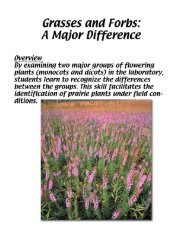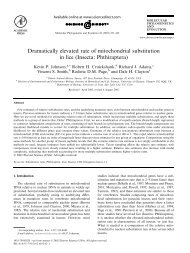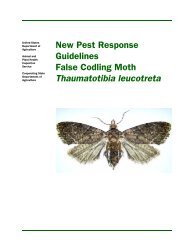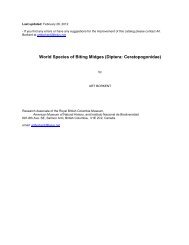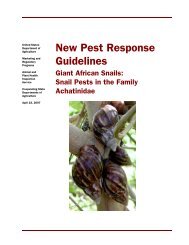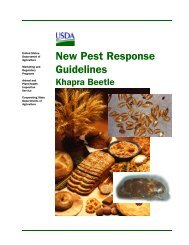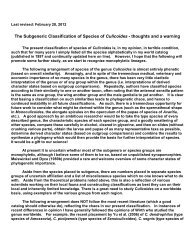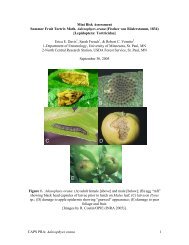Thaumatotibia leucotreta Mini Risk Assessment False codling moth
Thaumatotibia leucotreta Mini Risk Assessment False codling moth
Thaumatotibia leucotreta Mini Risk Assessment False codling moth
- No tags were found...
Create successful ePaper yourself
Turn your PDF publications into a flip-book with our unique Google optimized e-Paper software.
EggEggs. Egg development takes 2-22 days depending on temperature (Daiber 1979).Eggs are extremely sensitive to cold temperatures and extended periods of lowhumidity. Temperatures below 0°C over a 2-3 day period can kill eggs (Blomefield1978, Daiber 1979).Larvae wander for a short while before tunneling into the host fruit, where most of thelarval stage is spent (Blomefield 1978, La Croix and Thindwa 1986b, Newton andCrause 1990, Couilloud 1994). The duration of this stage may vary widely (from 4-173days), depending on temperature and host plant (Blomefield 1978; Daiber1979b)(Daiber 1979, Daiber 1989, Couilloud 1994). <strong>Thaumatotibia</strong> <strong>leucotreta</strong> has upto 5 instars (Bradley et al. 1979, Couilloud 1994). The last instar is typically completedin fruit. A larva prepare to pupate by leaving the fruit and spinning a cocoon with silkand soil particles (USDA 1984). Pupation occurs on the soil surface, in the soil, increvices under bark, in dropped fruit or in debris (Blomefield 1978, USDA 1984, LaCroix and Thindwa 1986a, Daiber 1989, Newton and Crause 1990).Pupae emerge slightly from the cocoon before adult emergence takes place. “Theempty pupal skin usually remains attached to the cocoon” (Daiber 1989).Under laboratory conditions, the pupal stage lasts between 2-33 days, depending ontemperature (Daiber 1989). Pupae are also sensitive to cold temperatures and heavyrainfall (Daiber 1989). Pupae that have completed ¼ to ½ of their development tend tobe more cold resistant than older or younger pupae (Myburgh and Bass 1969).Several studies have described the developmental threshold and accumulated degreedays necessary for the completion of each life stage (Table D1).StageTable D1. Developmental threshold and degree day requirementsfor <strong>Thaumatotibia</strong> <strong>leucotreta</strong>Developmental Degree Days NotesReferencethreshold (˚C) (± SE)11.93 51.2-69.3 Lab study (Daiber 1979)11.7 69.4±3.2 Calculated from (Daiber 1975)author’s dataLarva 11.6-12.5 156 Lab study (Daiber 1979)Pupa 11.9 174 (females) Lab study (Daiber 1979)186 (males)Adult 8 232±4.2 Male life span; (Daiber 1980)calculated fromauthor’s Table 18.1 229.8±3.8 Male life span;calculated fromauthor’s Table 5(Daiber 1975)9.5 243.5±12.3 Female life span;calculated fromauthor’s Table 1(Daiber 1980)CAPS PRA: <strong>Thaumatotibia</strong> <strong>leucotreta</strong> 29



